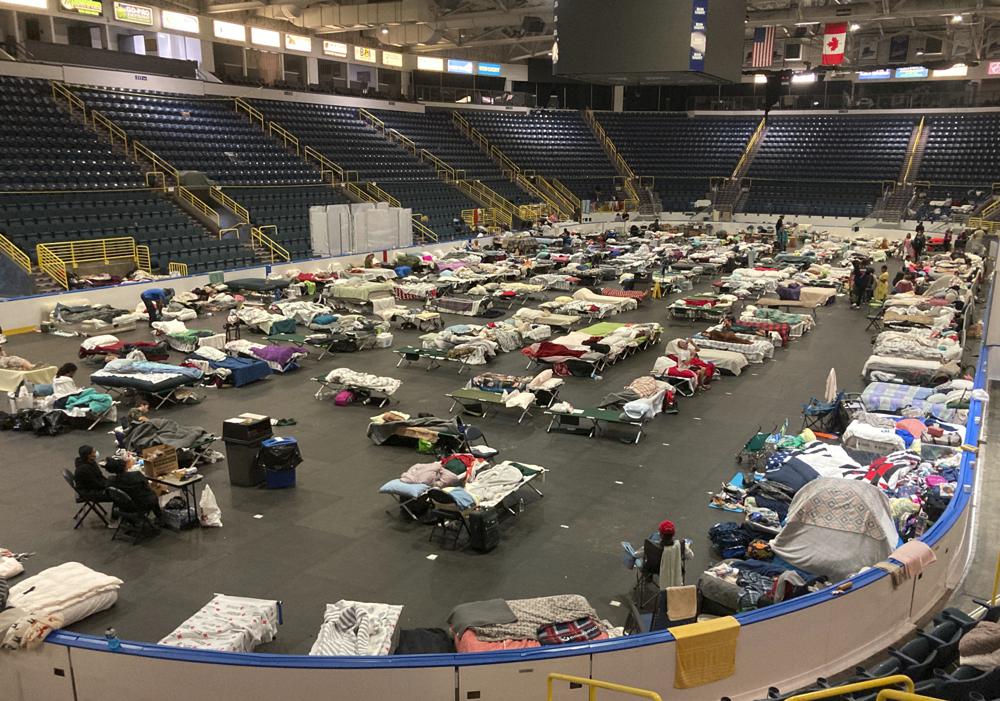
Just days after Hurricane Ian struck, a crowd of locals gathered under a huge banyan tree at a motel’s outdoor tiki bar for drink specials and live music. Less than 10 miles away, crews were finishing the search for bodies on a coastal barrier island. Even closer, entire families were trying to get comfortable for the night in a mass shelter housing more than 500 storm victims.
On a coast where a few miles meant the difference between life and death, relief and ruin, the contrasting scenes of reality less than two weeks since the hurricane’s onslaught are jarring, and they point to the way disaster can mean so many different things to different people.
Arlan Fuller has seen the disparity while working in the hurricane zone to serve marginalized communities with Project Hope, a nonprofit that provides medical relief services. A few factors seem to account for the vast differences from one place to the next, he said: People and places closest to the coast usually fared the worst, as did people with lower incomes.
“There’s an interesting combination of location, the sturdiness of the structure people lived in, and means,” said Fuller.
On Pine Island, where the state quickly erected a temporary bridge to replace one washed out by the storm, volunteers are handing out water, ice, food and supplies. The island’s Publix grocery store reopened with generator power faster than seemed possible, pleasing island resident Charlotte Smith, who didn’t evacuate.
“My home is OK. The lower level did flood somewhat. But I’m dry. They have the water back on running. Things are really getting pretty good.” Smith said.
Life is very different for Shanika Caldwell, 40, who took her nine children to a mass shelter located inside Hertz Arena, a minor league hockey coliseum, after another shelter located at a public high school shut down so classes could get ready to resume. The family was living in a motel before the storm but had to flee after the roof flew off, she said.
“If they say they are going to start school next week, how am I going to get my kids back and forth from school all the way here?” she said Saturday. Nearby, a huge silver statue of an ice hockey player looked out over the arena parking lot.
Ian, a strong Category 4 storm with 155 mph winds, was blamed for more than 100 deaths, the overwhelming majority of them in Southwest Florida. It was the third-deadliest storm to hit the U.S. mainland this century behind Hurricane Katrina, which left about 1,400 people dead, and Hurricane Sandy, which had a total death count of 233 despite weakening to a tropical storm just before it made landfall.
For some, the recovery has been fairly quick. Barber shops, car washes, chain restaurants, a gun range and vape shops — lots of vape shops — already have reopened on U.S. 41, known in southern Florida as the Tamiami Trail. Many traffic lights are operating, yet residents of low-lying homes and mobile home parks just off the highway are still shoveling mud that was left behind by floodwaters.
In Punta Gorda, near where boutiques and investment firms do business along a tony street lined by palm trees, Judy Jones, 74, is trying to provide for more than 40 residents of the bare-bones homeless shelter she’s operated for more than five decades, Bread of Life Mission Inc.
“I take care of people that fall through the crack in the system,” she said. “You have people who were on their feet but because of the hurricane, they’re on their knees.”
Cheryl Wiese isn’t homeless: For 16 years she spent the fall and winter months in her modest mobile home on Oyster Bay Lane, located at Fort Myers Beach, before returning to a place on Lake Erie in Ohio for the summer. But what she found after making the 24-hour drive south following Ian all but ruined her.
“I don’t want to even live here anymore. There is no Fort Myers Beach. All my neighbors are gone. All my friends are gone,” she said.
The worst part, she said, might have been driving past the devastation to the public library to begin the process of applying for assistance from the Federal Emergency Management Agency. A worker told her to be ready for a phone call and visit from a FEMA representative, and not to miss either, Wiese said.
“If I miss the phone call? Out of luck,” she said. “If I miss him? Out of luck.”
Danilo Mendoza, a construction worker from the Miami area whose trailer and tools were blown away by Ian, has seen the places where people are going on with life, where the recovery already is underway, but he’s doing his best to stay positive.
He counts himself fortunate because he has a safe place to stay at the hockey arena, which is located across the street from upscale apartments where people go on morning walks in athletic gear, and the food is abundant.
“I see the big picture,” he said. “They give you blankets, for God’s sake, brand new ones. They give you all the things you need to survive.”




One comment
Tom
October 9, 2022 at 7:31 pm
Tropical 2 sea tornadocane
Comments are closed.